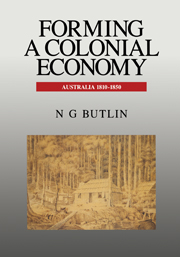Book contents
- Frontmatter
- Contents
- List of Tables
- List of Figures
- Acknowledgements
- Part I Forming an Economy
- Part II The Colonial Peopling of Australia: 1788–1850
- Part III Public Funding of Colonial Development: 1788–1850
- 5 Introduction
- 6 British Fiscal Characteristics
- 7 The Imperial Fisc in NSW and Van Diemen's Land to 1821
- 8 Broad Relations between British and Australian Fiscs to 1821
- 9 The Beginning of Local Budgeting: Real and Subterranean Budgets
- 10 The Conventional Legal Fisc in NSW: 1822–50
- Part IV The Colonial Australian Economy 1810–1840—A Historical, Statistical and Analytical Account
- Bibliography
- Appendixes
- Index
7 - The Imperial Fisc in NSW and Van Diemen's Land to 1821
from Part III - Public Funding of Colonial Development: 1788–1850
Published online by Cambridge University Press: 04 August 2010
- Frontmatter
- Contents
- List of Tables
- List of Figures
- Acknowledgements
- Part I Forming an Economy
- Part II The Colonial Peopling of Australia: 1788–1850
- Part III Public Funding of Colonial Development: 1788–1850
- 5 Introduction
- 6 British Fiscal Characteristics
- 7 The Imperial Fisc in NSW and Van Diemen's Land to 1821
- 8 Broad Relations between British and Australian Fiscs to 1821
- 9 The Beginning of Local Budgeting: Real and Subterranean Budgets
- 10 The Conventional Legal Fisc in NSW: 1822–50
- Part IV The Colonial Australian Economy 1810–1840—A Historical, Statistical and Analytical Account
- Bibliography
- Appendixes
- Index
Summary
Total British spending on New South Wales and Van Diemen's Land was distributed between several bodies (VDL was separated from NSW in 1825). The Victualling, Navy and Transport Boards organised and paid for the supplying and transporting of convicts to the settlements. The Paymasters (Army and Navy) and Colonial Agent transmitted salaries for military and civil officials respectively, as appropriated by parliament. The Commissary was the Treasury head of the network of Commissariats developed as supply, storage and distribution agencies particularly for overseas establishments. In NSW, this direct civilian link with the Treasury applied only during 1791–1813 after which the Commissariat became a military institution in NSW but remained, so far as Britain was concerned, in the Army subsection of the Treasury. The Audit Office of Treasury was charged with the task of auditing accounts of various spending agencies.
Table 7.1 shows one set of estimates of the reputed expenditures on British account during 1787–1822 by the various organisations concerned with NSW and VDL. These estimates are based on Bigge's papers derived and extended to 1822 by Jules Ginswick (unpub.) MS estimates. Access is gratefully acknowledged.
For various reasons, these estimates, particularly until 1817, need to be treated with a good deal of suspicion. The bills honoured by the British Treasury exceed by a considerable margin those drawn in NSW, VDL and Norfolk Island (cf. the fourth column of table 7.1 and the second column of table 7.2).
- Type
- Chapter
- Information
- Forming a Colonial EconomyAustralia 1810–1850, pp. 61 - 67Publisher: Cambridge University PressPrint publication year: 1994



